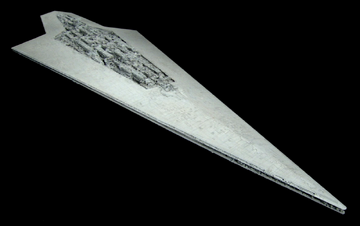| | |
[15]Admiral Ackbar, referring to the Executor, during the Battle of Endor
Super Star Destroyer (SSD) was a term used by Imperial, Rebel, New Republic and Galactic Alliance personnel for many dagger-shaped warship classes larger than Star Destroyers, ranging from Star Cruiser to Star Dreadnought models. In extreme cases, they were large enough to qualify as space stations.[6]
It was often used concurrently with the term Super-class Star Destroyer, both of which capitalized on the general "Star Destroyer" term, which, after getting popular exposure throughout the Clone Wars, came to symbolize weapons that in people's minds could destroy entire star systems.
Darth Vader's command ship, the Executor, was a Super Star Destroyer and one of the most famous Imperial vessels fielded, as was the even deadlier Eclipse, which served as one of Emperor Palpatine's flagships.
Characteristics
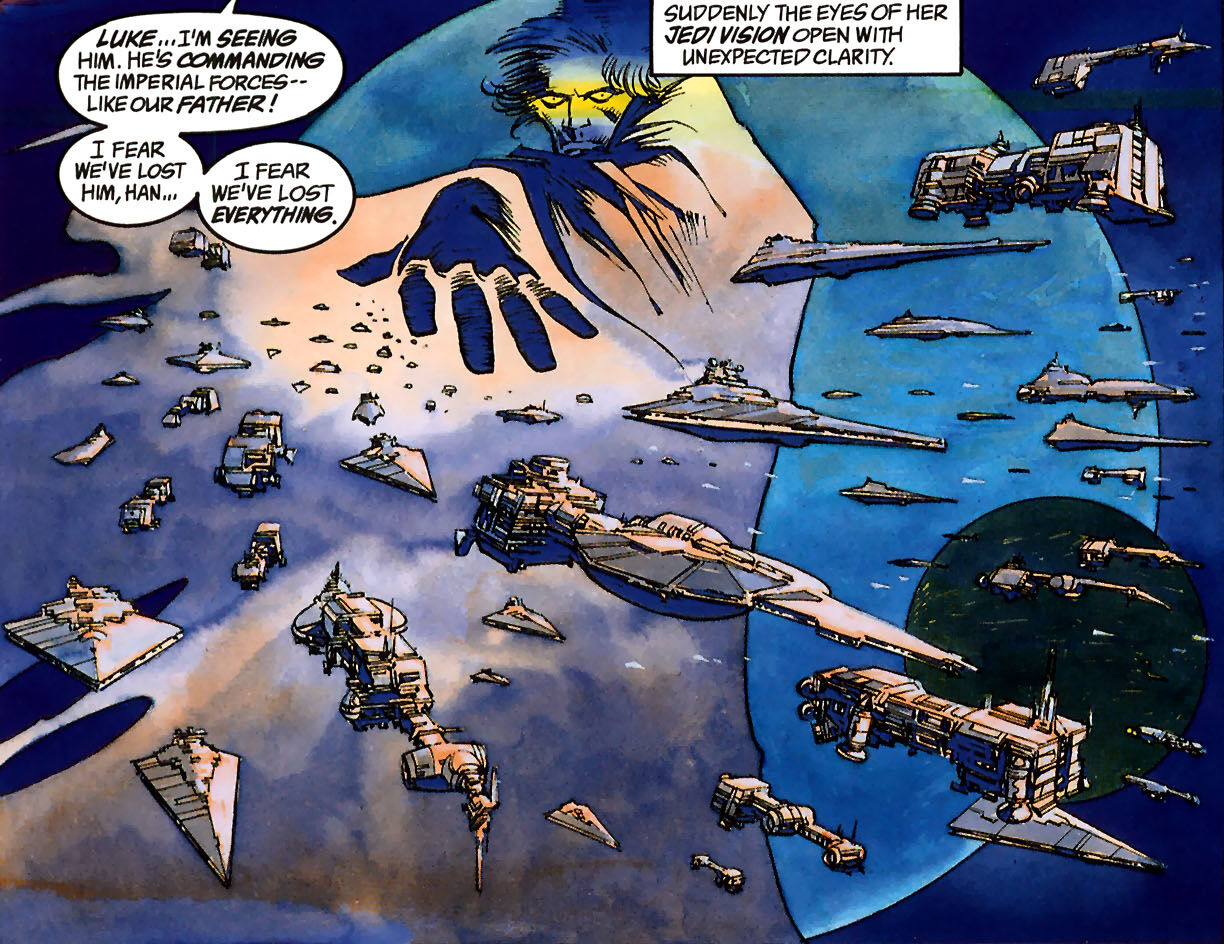
The term "Super Star Destroyer" described some of the largest warships ever designed and fielded, and covered various warship classes that served primarily as command ships. All the known models were at least several kilometers long in order to support their increasingly heavy power generators and armaments.[16] In at least one ship classification system, SSDs were regarded as large enough to be counted as space stations rather than regular starships.[17] In large part due to their immense size, Super Star Destroyers required a crew of at least 280,000 to operate. One of the leaders of the Rebel Alliance, Mon Mothma, admitted when learning this that it would pose a dilemma if the Rebel Alliance did manage to capture one intact: they wouldn't have enough personnel to operate it.[18]
The largest known models were usually fitted with extensive command and control suites[2] which could handle far more naval forces than previous command stations, such as the Old Republic's Republic command ships of the Krath Holy Crusade[19] or the Inexpugnable-class tactical command ships of the Mandalorian Wars.[20] Like most other starship production lines, different ships within the same class were often subject to different specifications in terms of armament, crew and support vessels, based on their intended focus and roles.[10][17]
Super Star Destroyers were on par with or larger than most other navies' ships-of-the-line, like the Trade Federation's Lucrehulk-class battleships or the Subjugator-class heavy cruisers of the CIS.[16][21] As command ships, SSDs like the Executor-class were capable of projecting power across entire Oversectors and served as command ships for galaxy-spanning campaigns.[5][7] They were good expressions of the Tarkin Doctrine, which argued that galactic peace could be achieved by developing the ability to project overwhelming firepower against any enemy, rendering all resistance futile before it even began.[2]
History
Origin
From Super Star Destroyers to torpedo spheres, it has been nearly impossible to overestimate the amount of destructive force available to the average Moff or Sector Group CommanderArhul Hextrophon, on the Empire's obsession with super weapons
For tens of thousands of years, heavy warships were part of the Republic Navy's strategy for space combat. Large ships fought in the Alsakan Conflicts and the Old Sith Wars. They became obsolete at some point after 3000 BBY, when fleet doctrine shifted to groups of smaller-scale cruisers that combined their firepower and were more maneuverable. These new designs were armed with better weapons and more powerful shields than the older battlecruisers and battleships.[22]
However, by the centuries prior to the Clone Wars, heavy warships had gained prominence again. The first modern design that would be lumped into the Super Star Destroyer category was the Procurator-class Star Battlecruiser, built two centuries before the Clone Wars. It spawned a series of increasingly large warship designs and went on to have many different models in its own production line.[4]
Large vessels like the Procurator were used for generations by private defensive fleets fielded by rich, industrialized star sectors.[4][9] Kuat, Corellia, and Humbarine were but three of the industrialized Core sectors that could afford to build such behemoths, which were fitted with hyperdrives with limited range to highlight their defensive purposes in the relative peace of the time.[23]
While a member of the Techno Union, the shipyards of Kuat began to experiment further in this period with warship designs that eclipsed previous generations.[9] Two decades prior to the Clone Wars, the shipyard unveiled the Mandator-class, a type of design that would fill out the modern dreadnought category in the Anaxes War College System.[4]

During the Clone Wars, heavy warship classes like the Star Battlecruisers and Star Dreadnoughts were used by the resurgent Republic Navy,[24] as large defense vessels.[4] Some battlecruisers were refitted to lead task forces on raids deep into Separatist territory.[4]
In the aftermath of the wars, the newly created Galactic Empire began an unprecedented research and development program for a new generation of heavy warship designs,[4][25] creating vessels that would bear the colloquial term Super Star Destroyer.[4]
Super Star Destroyer production was sometimes helped along by innovations in other areas. The Clone Wars saw the development of the Cardan-class space station series, which came to have some influence on the structuring of future naval projects, including the Super Star Destroyers and the Death Star battle stations.[26]
A few months after the end of the Clone Wars, the Sarlacc Project was begun. It sought to develop a new, heavy Imperial command ship. This vessel, an early prototype for a new generation of dreadnoughts, was 12 kilometers in length and meant to be filled with weapons. It was destroyed by early rebel elements before it could be completed.[25] Despite such an early setback, larger and more refined Star Dreadnought designs were eventually produced, notably the Executor-class[27] and Eclipse-class.[4][28]
The Executor-class became a highly sought after command ship, and the creation of the lead vessel and other members of the class was mired by political intrigue and misinformation campaigns.[4] When the Imperial Navy requested funds for construction of the Executor, it forged a profile on the vessel, calling it a Super-class Star Destroyer and making it out to be less than half its intended size, on par with the earlier Mandator- and Mandator II-classes.[4] This was done to avoid arousing suspicion in the Imperial Senate about the true nature of the design[2][27] as well as to capitalize on the popularity of the dagger-shaped Star Destroyer class, which dated back to the Clone Wars.[10][29] The Emperor's ultimate plan for these vessels was to have one Super Star Destroyer per sector, to serve as a command ship for Imperial forces stationed at the sector.[18]
The term was shortened to "Super Star Destroyer," and both it and the fake designation of Super-class remained in colloquial use long after the real name and designation had been revealed and the first vessel made operational.[30][31][32]
As these vessels came to play a greater role in naval doctrine, some officers and military planners derided the battlecruisers and dreadnoughts as a wasteful budgetary expense. They derisively referred to all the designs as Super Star Destroyers and argued that vessels at Star Destroyer scale and smaller were the only things needed to keep the Empire safe. With the advent and subsequent destruction of the first Death Star, the Navy reluctantly adopted SSDs as a viable and cheaper alternative. Due to their increased effectiveness as terror weapons, dreadnought production was prioritized over battlecruiser designs.[4]
Battlecruisers like the Praetor-class survived the transition into the Galactic Empire, but continued in limited service during the Galactic Civil War.[9] Battlecruisers were hampered by their relative inflexibility compared to Star Destroyers and the lack of heavier firepower compared to the dreadnought models.[4] The Praetor-class, for one, was considered outright outdated.[9]
"Super Star Destroyer" and "Super-class" later carried over to other warship designs in the following decades, with even the Rebel Alliance referring to anything bigger than a Star Destroyer by these terms.[5][27][29][33] Beyond the colloquialisms, many SSDs were referred to as "star dreadnoughts" as well, contrasting the usage of "star cruiser" (lowercase) to refer to Star Destroyers.[10]
Early Imperial production
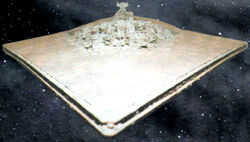
Before the Battle of Yavin, most Super Star Destroyer dreadnought production lines were still undergoing construction,[34] and the few partially constructed ships were only used as command centers[28][35] At least one Super Star Destroyer was also put in dry dock in the first Death Star some time before its destruction in 0 ABY.
Once the Empire realized the threat posed by an organized rebellion with the downfall of the first Death Star, the Super Star Destroyers began to be mass-produced, with an average Moff or Sector Group Commander estimated to have one or more such superweapons in their arsenal throughout the course of the Galactic Civil War, bringing the total number of ships up to thousands.[7] The Executor-class alone was believed to have had over 20 ships to its name, their combined bulk equating to that of thousands of individual Star Destroyers. Such heavy warships served both as sector as well as regional command centers[36] with individual ships kept off the records as black projects, sent into the Unknown Regions for secret missions, or stationed at hidden sites as additional assets.[4]
In addition to mass-production, influential individuals could afford customized designs at the height of the Empire. The Dark Jedi and Inquisitor Jerec had Kuat Drive Yards build a grandiose flagship for himself, replacing his Imperial-class Star Destroyer as a sign of his growing ambitions.[37] This vessel became the lead ship of its own class of dreadnoughts in addition to other dreadnought designs being produced during this period.[4]
Overall, despite consisting of several classes with multiple models in each category, each Super Star Destroyer production line was relatively short, compared to the prolific Star Destroyers.[4] There were still enough active ships around the time of the Battle of Hoth to make Rebel personnel also refer to them by the general term of Super Star Destroyer.[5][38]
While conventional armaments were designed for most ships, the two Eclipse-class dreadnoughts had a superlaser as their primary weapon. The bulk of these two Super-class Star Destroyers[39] was built around each ship's reactor and support systems, making them the most powerful conventional warships in history, and causing the design to attract unwanted attention from criminal third parties.[40]
Their construction took almost over a decade, with the Emperor's downfall leading to delays and shifts in logistics. They were estimated to be powerful enough to allow whoever controlled them a real chance at taking power in the galaxy. This also made them high-profile _targets by both the Rebel Alliance and, later, the New Republic.[10] As a symbol of its status, the Eclipse was escorted by smaller Super Star Destroyers during the Battle of Pinnacle Base.[41][42]
After Endor
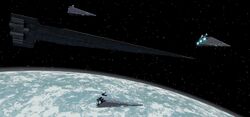
Following the Empire's collapse as a result of the Battle of Endor, it became increasingly difficult to maintain gargantuan warships, with the gradual breakdown and fracture of the Galactic Empire. Despite dozens of active battle groups being led by SSDs immediately after Endor,[10] the lack of cooperation between various parts of the Empire and the gradual rise to power of the New Republic led to many Super Star Destroyers being destroyed or captured.[10]
The focus switched to Star Destroyers or smaller vessels for the various Imperial warlords. Former support ships like the Strike-class medium cruiser saw a renewed service period as more mainline warships in the fleets of the Imperial Remnant.[10]
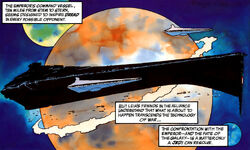
The last major SSD known to have been commissioned by legitimate Imperial forces was an Executor-class ship known as the Razor's Kiss. She was, however, destroyed by the New Republic soon after her launch from Kuat in 7.5 ABY.[43]
Over the years, the number of Super Star Destroyers dwindled as the older ships left in service were destroyed, captured, or kept in isolated Imperial enclaves. By the time Grand Admiral Thrawn took command of the Empire five years after Endor, his naval forces could not gain access to anything bigger than individual Star Destroyers.[44] Even warlords who kept diplomatic relations with Thrawn were hesitant to throw their dreadnoughts in with his forces.[4]
Concurrent with the warlordism, some fleet elements were recalled to the Deep Core, where scores of heavy warships became part of the "Dark Empire" ruled over by the clones of Palpatine. Here, the resurrected Emperor plotted their use as tools of conquest for six years after Endor, unleashing them alongside his fleets of World Devastators during the attempt at regaining his former glory with Operation Shadow Hand in 10 and 11 ABY.[4][7]
Prior to this operation, this Dark Empire retook large portions of the Core Worlds, beginning a vicious Imperial Civil War in the aftermath of the retaking of Coruscant from the New Republic. Twelve Super Star Destroyers were destroyed in the infighting, including the Mandator III-class dreadnoughts Aculeus and Panthac and the Executor-class dreadnought Whelm.[4] (And a few other Super Star Destroyers including these following classes of Super Star Destroyers, Vengeance-class dreadnoughts Executor-class dreadnoughts Mandator III-class-class dreadnoughts)
During the rise of the resurrected Palpatine, at least four 15-kilometer-long Sovereign-class Super Star Destroyers underwent construction, while the two Eclipse-class vessels were completed and fielded. These six vessels were meant to be the beginning of a new era of superlaser-armed warships, but with the destruction of Byss and the final death of the Emperor, they were all destroyed.[7]

The power having shifted to the New Republic, the threat of SSDs decreased. Despite this, the Republic constructed a counterpart to the Empire's Super Star Destroyers, with the Mon Calamari–produced Viscount-class Star Defender and Mediator-class battle cruiser filling holes in the Republic's naval forces.[45]
Apart from the Republic's new designs, several SSDs remained in the hands of foreign powers. One eight-kilometer-long SSD was observed in the fleet of the Imperial Remnant during the Yuuzhan Vong invasion[13] and at least one Executor was part of rogue Imperial pirate forces just prior to the start of this conflict.[46]
Further service

During the events surrounding the Swarm War, the Megador, a Super Star Destroyer equipped with sixteen engines, was used as flagship for the then-supreme commander of the Galactic Alliance Defense Force, Gilad Pellaeon.[31]
Super Star Destroyers were known to be used in the Second Galactic Civil War, with the Megador[47] and the Dominion[48] participating on the side of Darth Caedus's faction of the Galactic Alliance. At some point following the Second Galactic Civil War, heavy warships like the Star Defenders and Star Dreadnoughts were phased out of service, citing the expenses in operating the various designs.[49]
Legacy
By 130 ABY, the main-line Pellaeon-class Star Destroyer had some of its systems partially based on achievements made with the successful Executor-class.[10] The larger Imperious-class Star Destroyer was based on the Pellaeon and had a larger frame than the standard Star Destroyer classes of previous generations, but still shared their designation[49] rather than be rated a battlecruiser or a dreadnought.[4]
Designs
Allegiance-class battlecruiser

The 2,200 meter Allegiance-class design was a typical example of the Star Cruiser subclass of battlecruisers.[4] Allegiances were smaller Super Star Destroyers seen in use as escorts for larger vessels like the Eclipse-class. They had a design reminiscent of the Imperial-class Star Destroyer, only larger.[42] The class had a ventrally protruding reactor core and no visible launch bay.[41]
The Aramadia
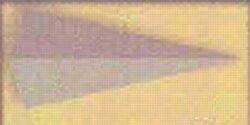
The Aramadia was an Imperial SSD that was captured by the Yevethans and acted as one of Nil Spaar's flagships during the Yevethan Purge in 16-17 ABY. Following the Battle of N'zoth and the end of the Purge, it was towed to N'zoth and used as a museum. In top-down profile, it resembled the Imperial-class Star Destroyer.[50]
The Arc Hammer
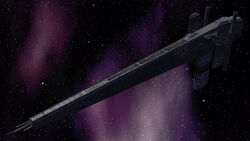
At least 9.6 km long, almost half as long as an Executor-class Star Dreadnought, the Arc Hammer was essentially an armed factory ship that also served as a command ship for the Dark Trooper Project. The design was very sleek compared to other Super Star Destroyers (similar only to Jerec's ship), and noteworthy for a large quadruple tower structure protruding from the dorsal and ventral side in the general area of the bridge structure. Dorsal bays could launch the ship's complement of Dark troopers onto a _target in a combat drop. The Arc Hammer was destroyed from within by Kyle Katarn's sabotage.[51]
Assertor-class Star Dreadnought
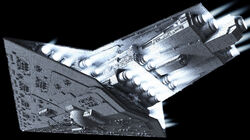
The 15,000 meter Assertor-class Star Dreadnought was a heavily armed Imperial Star Dreadnought. Ships of this class sometimes led elite units that used TIE/D Defender starfighter squadrons. Two were seen at Naval Station Validusia.
Bellator-class dreadnought

The 7,200 meter Bellator-class dreadnought was based on the earlier Mandator and Mandator II dreadnought models and was a slightly scaled down version of them. Several vessels were seen at Naval Station Validusia. Two Bellators were viewed by the commanders of Death Squadron at a fleet gathering prior to the Battle of Hoth.[4] At least one vessel later served in the forces of the resurrected Emperor Palpatine in 10 ABY. A Bellator was escorted by a Star Destroyer in orbit of Byss around this time.[41]
Eclipse-class dreadnought
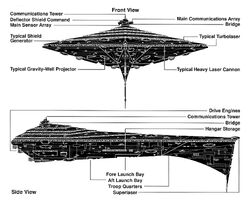
The Eclipse-class was designed as flagships for Emperor Palpatine and were constructed in relative secrecy. They were 17.5 kilometers in length, with much of their interiors taken up by generators used to power the ship's main weapon, a scaled-down superlaser. The class's design was meant to evoke ancient seagoing warships.[7]
Executor-class Star Dreadnought

The Executor-class Star Dreadnought was the first class associated with the SSD moniker.[2] It was 19 kilometers in length, was powered by a central reactor underneath its command tower, had over 5,000 various weapons-systems,[5] and could carry over a thousand starfighters in its multiple hangar bays.[12] Its design was meant to overwhelm any opposition, sending the enemy into retreat or resignation by its mere presence.[2] The class became popular within the Imperial Navy, and officers desired such ships as a status symbol.[52] Since the Super-class designation originated with this ship, it was often called Super-class Star Destroyer interchangeably with other terms.[2][10][53][54]
Mandator II-class Star Dreadnaught
The 8,000-meter Mandator II-class Star Dreadnaught was built and fielded by KDY and the Galactic Republic. The model served in the Republic Navy during the Clone Wars and guarded vital _targets from Separatist attacks.[4]
Mandator III-class dreadnought
The 12,000-meter Mandator III-class was built and fielded by the Galactic Empire. It was several kilometers longer than previous models and enlarged to carry massive armaments.[4]
The Megador
The Megador was a sixteen-engined SSD that served in the Imperial Remnant during the Orinda campaign and later on the Galactic Federation of Free Alliances.[31] It was armed with long-range turbolasers during the Second Galactic Civil War.[47]
Sovereign-class Super Star Destroyer

The Sovereign-class was a 15-kilometer, scaled-down version of the Eclipse-class, meant for mass production. Like the Eclipse, the Sovereign was armed with a superlaser as its primary weapon. None of the four initial ships survived the fall of the resurrected Palpatine, and all were destroyed before completion.[7]
Super Star Destroyer prototype
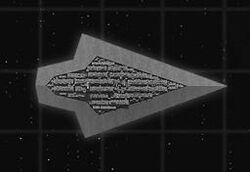
This ship, developed in the Sarlacc Project, was 12 kilometers long, had a central reactor, and was meant to be covered in armaments and serve as the Imperial Navy's symbolic flagship. It was destroyed while partially unfinished during the Battle of Byss. Despite its destruction, it served as a precursor to later classes, like the Executor.[25]
Vengeance-class dreadnought
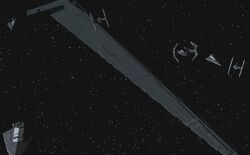
This 19,000-meter dreadnought model was used by the Galactic Empire. Several vessels participated in the prelude to Operation Shadow Hand, where at least one was destroyed during the infighting of the Imperial Civil War.[4]
Appearances
- Star Wars: Galactic Battlegrounds (Mentioned only)
- Star Wars: Galactic Battlegrounds: Clone Campaigns (Mentioned only)
- "The Core of Corruption" – Dawn of Defiance campaign (Mentioned only)
- "Jaws of the Sarlacc" – Dawn of Defiance campaign
- Star Wars: The Force Unleashed
- Star Wars: The Force Unleashed novelization (and unabridged audiobook)
- Star Wars: The Force Unleashed graphic novel (In flashback(s))
- Death Star
- Star Wars: Empire at War: Forces of Corruption
- Star Wars: X-Wing
- Star Wars: Dark Forces
- Star Wars: Dark Forces Remaster
- Star Wars: Rogue Squadron II: Rogue Leader
- Star Wars: Rogue Squadron III: Rebel Strike
- Star Wars: Rebellion
- Star Wars Missions 18: Rogue Squadron to the Rescue
- Star Wars: Imperial Ace
- Scoundrel's Luck
- Allegiance (and audiobook)
- "Darth Vader Strikes" (colorized in Classic Star Wars 2–4)
- "Traitor's Gambit" (colorized in Classic Star Wars 7–8) (In flashback(s))
- "The Return of Ben Kenobi" (colorized in Classic Star Wars 10–11)
- "The Power Gem" (colorized in Classic Star Wars 11–12) (Appears in hologram)
- "Revenge of the Jedi" (colorized in Classic Star Wars 13–14)
- "Doom Mission" (colorized in Classic Star Wars 14–15)
- "Race for Survival" (colorized in Classic Star Wars 15–17)
- "Showdown" (colorized in Classic Star Wars 20)
- "The Final Trap" (colorized in Classic Star Wars 20)
-
 "Sand Blasted" — Star Wars Tales 4
"Sand Blasted" — Star Wars Tales 4 - Operation: Elrood
- Galaxy of Fear: The Hunger
- Starfall (also reprinted in Classic Adventures: Volume Five) (Mentioned only)
- Star Wars Galaxies: An Empire Divided (Appeared in loading screen)
- The Game Chambers of Questal (also reprinted in Classic Adventures: Volume Five) (Mentioned only)
- Splinter of the Mind's Eye 3
- Star Wars: TIE Fighter Collector's CD-ROM (Mentioned only)
-
 "Galaxywide NewsNets" — Star Wars Adventure Journal 12
"Galaxywide NewsNets" — Star Wars Adventure Journal 12 -
 "Galaxywide NewsNets" — Star Wars Adventure Journal 13
"Galaxywide NewsNets" — Star Wars Adventure Journal 13 -
 "Galaxywide NewsNets" — Star Wars Adventure Journal 14
"Galaxywide NewsNets" — Star Wars Adventure Journal 14 - Star Wars: Episode V The Empire Strikes Back (First appearance)
- Star Wars (1977) 39 (colorized in Star Wars: A Long Time Ago... Volume 3: Resurrection of Evil and Star Wars: Episode V — The Empire Strikes Back (HC))
- Star Wars (1977) 40 (colorized in Star Wars: A Long Time Ago... Volume 3: Resurrection of Evil and Star Wars: Episode V — The Empire Strikes Back (HC))
- Star Wars: X-Wing Alliance
- Star Wars (1977) 41 (colorized in Star Wars: A Long Time Ago... Volume 3: Resurrection of Evil and Star Wars: Episode V — The Empire Strikes Back (HC))
- The Empire Strikes Back radio drama — "The Millennium Falcon Pursuit"
- The Empire Strikes Back radio drama — "Way of the Jedi"
- Star Wars (1977) 42 (colorized in Star Wars: A Long Time Ago... Volume 3: Resurrection of Evil and Star Wars: Episode V — The Empire Strikes Back (HC))
- The Empire Strikes Back radio drama — "New Allies, New Enemies"
- The Empire Strikes Back radio drama — "Gambler's Choice" (Indirect mention only)
- Star Wars (1977) 44 (colorized in Star Wars: A Long Time Ago... Volume 3: Resurrection of Evil and Star Wars: Episode V — The Empire Strikes Back (HC))
- The Empire Strikes Back radio drama — "The Clash of Lightsabers"
-
 "Temporary Reassignment" — Shadows of the Empire Sourcebook
"Temporary Reassignment" — Shadows of the Empire Sourcebook - Star Wars (1977) 60 (colorized in Star Wars: A Long Time Ago... Volume 4: Screams in the Void)
- Star Wars (1977) 61 (colorized in Star Wars: A Long Time Ago... Volume 4: Screams in the Void)
- Star Wars: X-Wing vs. TIE Fighter: Balance of Power Campaigns
-
 "The Emperor's Trophy" — Star Wars Galaxy Magazine 11 (Mentioned only)
"The Emperor's Trophy" — Star Wars Galaxy Magazine 11 (Mentioned only) - Star Wars: Rebel Assault II: The Hidden Empire
- Shadows of the Empire 1
- Star Wars: Shadows of the Empire novel
-
 "Hasty Exit" — Shadows of the Empire Sourcebook (Mentioned only)
"Hasty Exit" — Shadows of the Empire Sourcebook (Mentioned only) - Shadows of the Empire 5
- Shadows of the Empire 6
- The Rise and Fall of Darth Vader
- Star Wars: Episode VI Return of the Jedi
- Return of the Jedi 1 (colorized in Star Wars: Episode VI — Return of the Jedi (HC))
- Return of the Jedi 2 (colorized in Star Wars: Episode VI — Return of the Jedi (HC))
- Return of the Jedi radio drama — "Prophecies and Destinies" (Indirect mention only)
- Slave Ship
- Return of the Jedi 3 (colorized in Star Wars: Episode VI — Return of the Jedi (HC))
- Return of the Jedi radio drama — "Pattern and Web"
-
 "A Day in the Life" — Star Wars Tales 12
"A Day in the Life" — Star Wars Tales 12 -
 "Mara Jade: A Night on the Town" — Star Wars Tales 1 (Appears in hologram)
"Mara Jade: A Night on the Town" — Star Wars Tales 1 (Appears in hologram) - X-Wing Rogue Squadron 22 (Mentioned only)
- Dark Forces: Rebel Agent
- Star Wars: Jedi Knight: Dark Forces II
- Dark Forces: Jedi Knight
- X-Wing: Rogue Squadron (and unabridged audiobook) (Mentioned only)
- X-Wing: Wedge's Gamble (and unabridged audiobook)
- X-Wing: The Krytos Trap (and unabridged audiobook)
- X-Wing: The Bacta War (and unabridged audiobook)
- X-Wing: Iron Fist (and unabridged audiobook)
- X-Wing: Solo Command (and unabridged audiobook)
- The Courtship of Princess Leia (and unabridged audiobook)
- Heir to the Empire (and unabridged audiobook) (Mentioned only)
- X-Wing: Isard's Revenge
- Dark Empire audio drama
- Dark Empire 6 (First appearance)
- Empire's End audio drama
- Empire's End 1
- Empire's End 2
- Crimson Empire 5
- I, Jedi (and unabridged audiobook) (Vision to Corran Horn)
- Darksaber
- X-Wing: Starfighters of Adumar (Mentioned only)
-
 "Murder in Slushtime" — Star Wars Adventure Journal 14 (also reprinted in Hyperspace: The Official Star Wars Fan Club) ("Callista Ming" capsule) (Mentioned only)
"Murder in Slushtime" — Star Wars Adventure Journal 14 (also reprinted in Hyperspace: The Official Star Wars Fan Club) ("Callista Ming" capsule) (Mentioned only) - Before the Storm
- Shield of Lies
- Tyrant's Test
-
 "Two for One" — Star Wars Adventure Journal 15
"Two for One" — Star Wars Adventure Journal 15 - Young Jedi Knights: Shards of Alderaan (Mentioned only)
- The New Jedi Order: Dark Tide II: Ruin (Mentioned only)
- The New Jedi Order: Agents of Chaos I: Hero's Trial
- The New Jedi Order: Enemy Lines I: Rebel Dream
- The New Jedi Order: Enemy Lines II: Rebel Stand
- The New Jedi Order: Destiny's Way
- The New Jedi Order: The Unifying Force
- Dark Nest III: The Swarm War
- Legacy of the Force: Inferno
- Legacy of the Force: Fury (Mentioned only)
- Legacy of the Force: Revelation (Mentioned only)
- Legacy of the Force: Invincible
- Fate of the Jedi: Backlash (and audiobook) (Appears in hologram) (in Natasi Daala's office)
- Fate of the Jedi: Apocalypse (and audiobook)
- "Celestia Galactica Photografica" — Star Wars: Visionaries
Non-canon appearances
- ° Star Wars Infinities: A New Hope
- ° Star Wars Infinities: The Empire Strikes Back
- ° Star Wars Infinities: Return of the Jedi
Sources
- The Empire Strikes Back Sketchbook
- The Art of Star Wars Episode V: The Empire Strikes Back
- The Art of Star Wars Episode VI: Return of the Jedi
- A Guide to the Star Wars Universe
- Star Warriors: Starfighter Combat in the Star Wars Universe
- Galaxy Guide 1: A New Hope
-
 "Starfighters Down" — Challenge 38 (Unlicensed)
"Starfighters Down" — Challenge 38 (Unlicensed) - Imperial Sourcebook
- Galaxy Guide 3: The Empire Strikes Back
- Galaxy Guide 5: Return of the Jedi
- The Rebel Alliance Sourcebook
- Heir to the Empire Sourcebook
- Dark Empire Sourcebook
- Wanted by Cracken
- The Movie Trilogy Sourcebook
- Han Solo and the Corporate Sector Sourcebook
- The Art of Star Wars Galaxy
- A Guide to the Star Wars Universe, Second Edition, Revised and Expanded
- The Rebel Alliance Sourcebook, Second Edition
-
 "Recon & Report: The Journey to Coruscant" — Star Wars Adventure Journal 2 (also reprinted in The Best of the Star Wars Adventure Journal, Issues 1-4)
"Recon & Report: The Journey to Coruscant" — Star Wars Adventure Journal 2 (also reprinted in The Best of the Star Wars Adventure Journal, Issues 1-4) - Imperial Sourcebook, Second Edition
-
 "The Pentastar Alignment" — Star Wars Adventure Journal 3
"The Pentastar Alignment" — Star Wars Adventure Journal 3 - From Star Wars to Indiana Jones: The Best of the Lucasfilm Archives
- Platt's Starport Guide
- Dark Forces Official Player's Guide
- The Empire Strikes Back: The National Public Radio Dramatization
- The Essential Guide to Characters
- The Illustrated Star Wars Universe
- Heroes & Rogues
- Galaxy Guide 5: Return of the Jedi, Second Edition
- The Truce at Bakura Sourcebook
- The Essential Guide to Vehicles and Vessels
- TIE Fighter Collector's CD-ROM: The Official Strategy Guide
- The Galactic Empire—Ships of the Fleet
- The Secrets of Star Wars: Shadows of the Empire
- Shadows of the Empire Sourcebook
- Star Wars: The Roleplaying Game, Second Edition, Revised and Expanded
-
1996 Topps Star Wars: Shadows of the Empire (Card: Vader Destroys the Rebel Base) (backup link)
- Return of the Jedi: The National Public Radio Dramatization
-
 Star Wars Customizable Card Game — Hoth Limited (Card: Admiral Ozzel) (backup link) (Picture only)
Star Wars Customizable Card Game — Hoth Limited (Card: Admiral Ozzel) (backup link) (Picture only) -
 Star Wars Customizable Card Game — Hoth Limited (Card: Captain Piett) (backup link)
Star Wars Customizable Card Game — Hoth Limited (Card: Captain Piett) (backup link) -
 Star Wars Customizable Card Game — Hoth Limited (Card: ComScan Detection) (backup link) (Picture only)
Star Wars Customizable Card Game — Hoth Limited (Card: ComScan Detection) (backup link) (Picture only) -
 Star Wars Customizable Card Game — Hoth Limited (Card: Dark Dissension) (backup link) (Picture only)
Star Wars Customizable Card Game — Hoth Limited (Card: Dark Dissension) (backup link) (Picture only) -
 Star Wars Customizable Card Game — Hoth Limited (Card: Death Squadron) (backup link) (Picture only)
Star Wars Customizable Card Game — Hoth Limited (Card: Death Squadron) (backup link) (Picture only) -
 Star Wars Customizable Card Game — Hoth Limited (Card: Imperial Domination) (backup link) (Picture only)
Star Wars Customizable Card Game — Hoth Limited (Card: Imperial Domination) (backup link) (Picture only) -
 Star Wars Customizable Card Game — Hoth Limited (Card: That's It, The Rebels Are There!) (backup link) (Picture only)
Star Wars Customizable Card Game — Hoth Limited (Card: That's It, The Rebels Are There!) (backup link) (Picture only) -
 Star Wars Customizable Card Game — Hoth Limited (Card: You Have Failed Me For The Last Time) (backup link) (Picture only)
Star Wars Customizable Card Game — Hoth Limited (Card: You Have Failed Me For The Last Time) (backup link) (Picture only)
- Galaxy Guide 3: The Empire Strikes Back, Second Edition
- The Complete Star Wars Trilogy Scrapbook
-
 Star Wars Customizable Card Game — The Empire Strikes Back Introductory Two-Player Game (Card: Veers) (backup link) (Picture only)
Star Wars Customizable Card Game — The Empire Strikes Back Introductory Two-Player Game (Card: Veers) (backup link) (Picture only)
-
 Star Wars Customizable Card Game — Dagobah Limited (Card: 4-LOM) (backup link) (Picture only)
Star Wars Customizable Card Game — Dagobah Limited (Card: 4-LOM) (backup link) (Picture only) -
 Star Wars Customizable Card Game — Dagobah Limited (Card: 4-LOM's Concussion Rifle) (backup link) (Picture only)
Star Wars Customizable Card Game — Dagobah Limited (Card: 4-LOM's Concussion Rifle) (backup link) (Picture only) -
 Star Wars Customizable Card Game — Dagobah Limited (Card: Apology Accepted) (backup link) (Picture only)
Star Wars Customizable Card Game — Dagobah Limited (Card: Apology Accepted) (backup link) (Picture only) -
 Star Wars Customizable Card Game — Dagobah Limited (Card: Asteroids Do Not Concern Me) (backup link) (Picture only)
Star Wars Customizable Card Game — Dagobah Limited (Card: Asteroids Do Not Concern Me) (backup link) (Picture only) -
 Star Wars Customizable Card Game — Dagobah Limited (Card: Bossk) (backup link) (Picture only)
Star Wars Customizable Card Game — Dagobah Limited (Card: Bossk) (backup link) (Picture only) -
 Star Wars Customizable Card Game — Dagobah Limited (Card: Bossk's Mortar Gun) (backup link) (Picture only)
Star Wars Customizable Card Game — Dagobah Limited (Card: Bossk's Mortar Gun) (backup link) (Picture only) -
 Star Wars Customizable Card Game — Dagobah Limited (Card: Comm Chief) (backup link) (Picture only)
Star Wars Customizable Card Game — Dagobah Limited (Card: Comm Chief) (backup link) (Picture only) -
 Star Wars Customizable Card Game — Dagobah Limited (Card: Commander Brandei) (backup link)
Star Wars Customizable Card Game — Dagobah Limited (Card: Commander Brandei) (backup link) -
 Star Wars Customizable Card Game — Dagobah Limited (Card: Commander Gherant) (backup link)
Star Wars Customizable Card Game — Dagobah Limited (Card: Commander Gherant) (backup link) -
 Star Wars Customizable Card Game — Dagobah Limited (Card: Control (Dark)) (backup link) (Picture only)
Star Wars Customizable Card Game — Dagobah Limited (Card: Control (Dark)) (backup link) (Picture only) -
 Star Wars Customizable Card Game — Dagobah Limited (Card: Corporal Derdram) (backup link)
Star Wars Customizable Card Game — Dagobah Limited (Card: Corporal Derdram) (backup link) -
 Star Wars Customizable Card Game — Dagobah Limited (Card: Corporal Vandolay) (backup link)
Star Wars Customizable Card Game — Dagobah Limited (Card: Corporal Vandolay) (backup link) -
 Star Wars Customizable Card Game — Dagobah Limited (Card: Dengar) (backup link) (Picture only)
Star Wars Customizable Card Game — Dagobah Limited (Card: Dengar) (backup link) (Picture only) -
 Star Wars Customizable Card Game — Dagobah Limited (Card: Dengar's Blaster Carbine) (backup link) (Picture only)
Star Wars Customizable Card Game — Dagobah Limited (Card: Dengar's Blaster Carbine) (backup link) (Picture only) -
 Star Wars Customizable Card Game — Dagobah Limited (Card: Executor) (backup link)
Star Wars Customizable Card Game — Dagobah Limited (Card: Executor) (backup link) -
 Star Wars Customizable Card Game — Dagobah Limited (Card: Executor: Comm Station) (backup link)
Star Wars Customizable Card Game — Dagobah Limited (Card: Executor: Comm Station) (backup link) -
 Star Wars Customizable Card Game — Dagobah Limited (Card: Executor: Control Station) (backup link)
Star Wars Customizable Card Game — Dagobah Limited (Card: Executor: Control Station) (backup link) -
 Star Wars Customizable Card Game — Dagobah Limited (Card: Executor: Holotheatre) (backup link)
Star Wars Customizable Card Game — Dagobah Limited (Card: Executor: Holotheatre) (backup link) -
 Star Wars Customizable Card Game — Dagobah Limited (Card: Executor: Main Corridor) (backup link)
Star Wars Customizable Card Game — Dagobah Limited (Card: Executor: Main Corridor) (backup link) -
 Star Wars Customizable Card Game — Dagobah Limited (Card: Executor: Meditation Chamber) (backup link)
Star Wars Customizable Card Game — Dagobah Limited (Card: Executor: Meditation Chamber) (backup link) -
 Star Wars Customizable Card Game — Dagobah Limited (Card: Field Promotion) (backup link)
Star Wars Customizable Card Game — Dagobah Limited (Card: Field Promotion) (backup link) -
 Star Wars Customizable Card Game — Dagobah Limited (Card: Flagship) (backup link)
Star Wars Customizable Card Game — Dagobah Limited (Card: Flagship) (backup link) -
 Star Wars Customizable Card Game — Dagobah Limited (Card: HoloNet Transmission) (backup link) (Picture only)
Star Wars Customizable Card Game — Dagobah Limited (Card: HoloNet Transmission) (backup link) (Picture only) -
 Star Wars Customizable Card Game — Dagobah Limited (Card: IG-88) (backup link) (Picture only)
Star Wars Customizable Card Game — Dagobah Limited (Card: IG-88) (backup link) (Picture only) -
 Star Wars Customizable Card Game — Dagobah Limited (Card: IG-88's Neural Inhibitor) (backup link) (Picture only)
Star Wars Customizable Card Game — Dagobah Limited (Card: IG-88's Neural Inhibitor) (backup link) (Picture only) -
 Star Wars Customizable Card Game — Dagobah Limited (Card: IG-88's Pulse Cannon) (backup link) (Picture only)
Star Wars Customizable Card Game — Dagobah Limited (Card: IG-88's Pulse Cannon) (backup link) (Picture only) -
 Star Wars Customizable Card Game — Dagobah Limited (Card: IG-88's Pulse Cannon) (backup link) (Picture only)
Star Wars Customizable Card Game — Dagobah Limited (Card: IG-88's Pulse Cannon) (backup link) (Picture only) -
 Star Wars Customizable Card Game — Dagobah Limited (Card: Imperial Helmsman) (backup link) (Picture only)
Star Wars Customizable Card Game — Dagobah Limited (Card: Imperial Helmsman) (backup link) (Picture only) -
 Star Wars Customizable Card Game — Dagobah Limited (Card: Lieutenant Commander Ardan) (backup link)
Star Wars Customizable Card Game — Dagobah Limited (Card: Lieutenant Commander Ardan) (backup link) -
 Star Wars Customizable Card Game — Dagobah Limited (Card: Lieutenant Suba) (backup link)
Star Wars Customizable Card Game — Dagobah Limited (Card: Lieutenant Suba) (backup link) -
 Star Wars Customizable Card Game — Dagobah Limited (Card: Lieutenant Venka) (backup link)
Star Wars Customizable Card Game — Dagobah Limited (Card: Lieutenant Venka) (backup link) -
 Star Wars Customizable Card Game — Dagobah Limited (Card: No Disintegrations!) (backup link) (Picture only)
Star Wars Customizable Card Game — Dagobah Limited (Card: No Disintegrations!) (backup link) (Picture only) -
 Star Wars Customizable Card Game — Dagobah Limited (Card: Report To Lord Vader) (backup link) (Picture only)
Star Wars Customizable Card Game — Dagobah Limited (Card: Report To Lord Vader) (backup link) (Picture only) -
 Star Wars Customizable Card Game — Dagobah Limited (Card: Res Luk Ra'auf) (backup link) (Picture only)
Star Wars Customizable Card Game — Dagobah Limited (Card: Res Luk Ra'auf) (backup link) (Picture only) -
 Star Wars Customizable Card Game — Dagobah Limited (Card: The Dark Path) (backup link) (Picture only)
Star Wars Customizable Card Game — Dagobah Limited (Card: The Dark Path) (backup link) (Picture only) -
 Star Wars Customizable Card Game — Dagobah Limited (Card: Transmission Terminated) (backup link) (Picture only)
Star Wars Customizable Card Game — Dagobah Limited (Card: Transmission Terminated) (backup link) (Picture only) -
 Star Wars Customizable Card Game — Dagobah Limited (Card: Visage of the Emperor) (backup link) (Picture only)
Star Wars Customizable Card Game — Dagobah Limited (Card: Visage of the Emperor) (backup link) (Picture only) -
 Star Wars Customizable Card Game — Dagobah Limited (Card: Warrant Officer M'Kae) (backup link)
Star Wars Customizable Card Game — Dagobah Limited (Card: Warrant Officer M'Kae) (backup link) -
 Star Wars Customizable Card Game — Dagobah Limited (Card: We Don't Need Their Scum) (backup link) (Picture only)
Star Wars Customizable Card Game — Dagobah Limited (Card: We Don't Need Their Scum) (backup link) (Picture only) -
 Star Wars Customizable Card Game — Dagobah Limited (Card: What Is Thy Bidding, My Master?) (backup link) (Picture only)
Star Wars Customizable Card Game — Dagobah Limited (Card: What Is Thy Bidding, My Master?) (backup link) (Picture only) -
 Star Wars Customizable Card Game — Dagobah Limited (Card: Zuckuss) (backup link) (Picture only)
Star Wars Customizable Card Game — Dagobah Limited (Card: Zuckuss) (backup link) (Picture only)
- Lords of the Expanse
- Cracken's Threat Dossier
- Star Wars: The Annotated Screenplays
- Star Wars Trilogy Sourcebook, Special Edition
- The Essential Guide to Weapons and Technology
- Star Wars: The Art of the Brothers Hildebrandt
-
 Star Wars Customizable Card Game — Cloud City Limited (Card: Chief Retwin) (backup link) (Picture only)
Star Wars Customizable Card Game — Cloud City Limited (Card: Chief Retwin) (backup link) (Picture only) -
 Star Wars Customizable Card Game — Cloud City Limited (Card: Imperial Trooper Guard Dainsom) (backup link) (Picture only)
Star Wars Customizable Card Game — Cloud City Limited (Card: Imperial Trooper Guard Dainsom) (backup link) (Picture only) -
 Star Wars Customizable Card Game — Cloud City Limited (Card: Lieutenant Cecius) (backup link) (Picture only)
Star Wars Customizable Card Game — Cloud City Limited (Card: Lieutenant Cecius) (backup link) (Picture only) -
 Star Wars Customizable Card Game — Cloud City Limited (Card: TIE Sentry Ships) (backup link)
Star Wars Customizable Card Game — Cloud City Limited (Card: TIE Sentry Ships) (backup link)
- Star Wars: The Action Figure Archive
-
 "Around the Galaxy" — Star Wars Galaxy Collector 1
"Around the Galaxy" — Star Wars Galaxy Collector 1 - Star Wars: Rebellion: Prima's Official Strategy Guide
- Star Wars Encyclopedia
- The Essential Guide to Planets and Moons
-
 Star Wars Customizable Card Game — Second Anthology (Card: Flagship Operations) (backup link) (Picture only)
Star Wars Customizable Card Game — Second Anthology (Card: Flagship Operations) (backup link) (Picture only) - Star Wars: Behind the Magic
- TIE Fighter: A Pocket Manual (Picture only)
- Star Wars: Incredible Cross-Sections
-
 Star Wars Customizable Card Game — Special Edition Limited (Card: Alert My Star Destroyer!) (backup link) (Indirect mention only)
Star Wars Customizable Card Game — Special Edition Limited (Card: Alert My Star Destroyer!) (backup link) (Indirect mention only) -
 Star Wars Customizable Card Game — Special Edition Limited (Card: Dreaded Imperial Starfleet) (backup link) (Picture only)
Star Wars Customizable Card Game — Special Edition Limited (Card: Dreaded Imperial Starfleet) (backup link) (Picture only) -
 Star Wars Customizable Card Game — Special Edition Limited (Card: Executor: Docking Bay) (backup link)
Star Wars Customizable Card Game — Special Edition Limited (Card: Executor: Docking Bay) (backup link) -
 Star Wars Customizable Card Game — Special Edition Limited (Card: OS-72-10) (backup link)
Star Wars Customizable Card Game — Special Edition Limited (Card: OS-72-10) (backup link) -
 Star Wars Customizable Card Game — Special Edition Limited (Card: Oppressive Enforcement) (backup link) (Picture only)
Star Wars Customizable Card Game — Special Edition Limited (Card: Oppressive Enforcement) (backup link) (Picture only) -
 Star Wars Customizable Card Game — Special Edition Limited (Card: Star Destroyer!) (backup link) (Indirect mention only)
Star Wars Customizable Card Game — Special Edition Limited (Card: Star Destroyer!) (backup link) (Indirect mention only)
-
 Star Wars Customizable Card Game — Endor Limited (Card: Fly Casual) (backup link) (Picture only)
Star Wars Customizable Card Game — Endor Limited (Card: Fly Casual) (backup link) (Picture only) -
 Star Wars Customizable Card Game — Endor Limited (Card: It's An Older Code) (backup link) (Picture only)
Star Wars Customizable Card Game — Endor Limited (Card: It's An Older Code) (backup link) (Picture only)
-
 Star Wars Customizable Card Game — Death Star II Limited (Card: Admiral Piett) (backup link) (Picture only)
Star Wars Customizable Card Game — Death Star II Limited (Card: Admiral Piett) (backup link) (Picture only) -
 Star Wars Customizable Card Game — Death Star II Limited (Card: Black 11) (backup link)
Star Wars Customizable Card Game — Death Star II Limited (Card: Black 11) (backup link) -
 Star Wars Customizable Card Game — Death Star II Limited (Card: Blue Squadron 5) (backup link)
Star Wars Customizable Card Game — Death Star II Limited (Card: Blue Squadron 5) (backup link) -
 Star Wars Customizable Card Game — Death Star II Limited (Card: Chimaera) (backup link)
Star Wars Customizable Card Game — Death Star II Limited (Card: Chimaera) (backup link) -
 Star Wars Customizable Card Game — Death Star II Limited (Card: Commander Merrejk) (backup link) (Picture only)
Star Wars Customizable Card Game — Death Star II Limited (Card: Commander Merrejk) (backup link) (Picture only) -
 Star Wars Customizable Card Game — Death Star II Limited (Card: Concentrate All Fire) (backup link) (Picture only)
Star Wars Customizable Card Game — Death Star II Limited (Card: Concentrate All Fire) (backup link) (Picture only) -
 Star Wars Customizable Card Game — Death Star II Limited (Card: Flagship Executor) (backup link)
Star Wars Customizable Card Game — Death Star II Limited (Card: Flagship Executor) (backup link) -
 Star Wars Customizable Card Game — Death Star II Limited (Card: Flagship Operations) (backup link) (Picture only)
Star Wars Customizable Card Game — Death Star II Limited (Card: Flagship Operations) (backup link) (Picture only) -
 Star Wars Customizable Card Game — Death Star II Limited (Card: Inconsequential Losses) (backup link) (Picture only)
Star Wars Customizable Card Game — Death Star II Limited (Card: Inconsequential Losses) (backup link) (Picture only) -
 Star Wars Customizable Card Game — Death Star II Limited (Card: Intensify The Forward Batteries) (backup link) (Picture only)
Star Wars Customizable Card Game — Death Star II Limited (Card: Intensify The Forward Batteries) (backup link) (Picture only) -
 Star Wars Customizable Card Game — Death Star II Limited (Card: Leave Them To Me) (backup link) (Picture only)
Star Wars Customizable Card Game — Death Star II Limited (Card: Leave Them To Me) (backup link) (Picture only) -
 Star Wars Customizable Card Game — Death Star II Limited (Card: Menace Fades) (backup link)
Star Wars Customizable Card Game — Death Star II Limited (Card: Menace Fades) (backup link) -
 Star Wars Customizable Card Game — Death Star II Limited (Card: Prepared Defenses) (backup link) (Picture only)
Star Wars Customizable Card Game — Death Star II Limited (Card: Prepared Defenses) (backup link) (Picture only) -
 Star Wars Customizable Card Game — Death Star II Limited (Card: Something Special Planned For Them) (backup link) (Picture only)
Star Wars Customizable Card Game — Death Star II Limited (Card: Something Special Planned For Them) (backup link) (Picture only)
- A Guide to the Star Wars Universe, Third Edition, Revised and Expanded
- Rebellion Era Sourcebook
- Starships of the Galaxy
- The Official Star Wars Fact File 1 (COR 1-4: Coruscant)
- The Official Star Wars Fact File 4 (HOT 1-6: The Battle of Hoth)
- The Official Star Wars Fact File 4 (OZZ 1-2: Admiral Ozzel)
- The Official Star Wars Fact File 11 (STA 3-4: Imperial Star Destroyer)
- The Official Star Wars Fact File 13 (AWI 1-2: A-Wing Starfighter)
- The New Essential Guide to Characters
- The Official Star Wars Fact File 19 (VAD 7-12: Darth Vader)
- The Official Star Wars Fact File 21 (SKY 9-12: Luke Skywalker)
-
 "Super Star" on Wizards.com (content now obsolete; backup link)
"Super Star" on Wizards.com (content now obsolete; backup link) - The Official Star Wars Fact File 42 (MED 1-2: Meditation Chamber)
- The Official Star Wars Fact File 43 (SHI 1-4: Energy Shields)
- The Official Star Wars Fact File 47 (EXE 1-2: Executor)
- Coruscant and the Core Worlds
- The Official Star Wars Fact File 61 (BOU 15-16: Bounty Hunters – Zuckuss)
- The Official Star Wars Fact File 70 (PIE 1-2: Firmus Piett)
- The Official Star Wars Fact File 79 (END 29-30: The Battle of Endor)
- The Official Star Wars Fact File 89 (PIE 3-6: Admiral Firmus Piett)
- The New Essential Guide to Vehicles and Vessels
- The Official Star Wars Fact File 94 (YAV 13-16: The Evacuation of Yavin)
- Star Wars: Rogue Squadron III: Rebel Strike: The Official Nintendo Player's Guide
-
 Star Wars Trading Card Game — The Empire Strikes Back (Card: Admiral Firmus Piett (A)) (backup link) (Picture only)
Star Wars Trading Card Game — The Empire Strikes Back (Card: Admiral Firmus Piett (A)) (backup link) (Picture only) -
 Star Wars Trading Card Game — The Empire Strikes Back (Card: Admiral Firmus Piett (B)) (backup link) (Picture only)
Star Wars Trading Card Game — The Empire Strikes Back (Card: Admiral Firmus Piett (B)) (backup link) (Picture only) -
 Star Wars Trading Card Game — The Empire Strikes Back (Card: Admiral Kendal Ozzel (A)) (backup link) (Picture only)
Star Wars Trading Card Game — The Empire Strikes Back (Card: Admiral Kendal Ozzel (A)) (backup link) (Picture only) -
 Star Wars Trading Card Game — The Empire Strikes Back (Card: Blockade) (backup link) (Picture only)
Star Wars Trading Card Game — The Empire Strikes Back (Card: Blockade) (backup link) (Picture only) -
 Star Wars Trading Card Game — The Empire Strikes Back (Card: Emperor's Bidding) (backup link) (Picture only)
Star Wars Trading Card Game — The Empire Strikes Back (Card: Emperor's Bidding) (backup link) (Picture only) -
 Star Wars Trading Card Game — The Empire Strikes Back (Card: Executor (A)) (backup link)
Star Wars Trading Card Game — The Empire Strikes Back (Card: Executor (A)) (backup link) -
 Star Wars Trading Card Game — The Empire Strikes Back (Card: Executor Bridge) (backup link)
Star Wars Trading Card Game — The Empire Strikes Back (Card: Executor Bridge) (backup link) -
 Star Wars Trading Card Game — The Empire Strikes Back (Card: Executor Hangar) (backup link)
Star Wars Trading Card Game — The Empire Strikes Back (Card: Executor Hangar) (backup link) -
 Star Wars Trading Card Game — The Empire Strikes Back (Card: Failed for the Last Time) (backup link) (Picture only)
Star Wars Trading Card Game — The Empire Strikes Back (Card: Failed for the Last Time) (backup link) (Picture only) -
 Star Wars Trading Card Game — The Empire Strikes Back (Card: Imperial Fleet) (backup link) (Picture only)
Star Wars Trading Card Game — The Empire Strikes Back (Card: Imperial Fleet) (backup link) (Picture only) -
 Star Wars Trading Card Game — The Empire Strikes Back (Card: Imperial II Star Destroyer) (backup link) (Picture only)
Star Wars Trading Card Game — The Empire Strikes Back (Card: Imperial II Star Destroyer) (backup link) (Picture only) -
 Star Wars Trading Card Game — The Empire Strikes Back (Card: Meditation Chamber) (backup link) (Picture only)
Star Wars Trading Card Game — The Empire Strikes Back (Card: Meditation Chamber) (backup link) (Picture only) -
 Star Wars Trading Card Game — The Empire Strikes Back (Card: Navy Trooper) (backup link) (Picture only)
Star Wars Trading Card Game — The Empire Strikes Back (Card: Navy Trooper) (backup link) (Picture only) -
 Star Wars Trading Card Game — The Empire Strikes Back (Card: Sacrifice) (backup link) (Picture only)
Star Wars Trading Card Game — The Empire Strikes Back (Card: Sacrifice) (backup link) (Picture only) -
 Star Wars Trading Card Game — The Empire Strikes Back (Card: Search for the Rebels) (backup link) (Picture only)
Star Wars Trading Card Game — The Empire Strikes Back (Card: Search for the Rebels) (backup link) (Picture only) -
 Star Wars Trading Card Game — The Empire Strikes Back (Card: TIE Bomber EX-1-2) (backup link) (Picture only)
Star Wars Trading Card Game — The Empire Strikes Back (Card: TIE Bomber EX-1-2) (backup link) (Picture only) -
 Star Wars Trading Card Game — The Empire Strikes Back (Card: TIE Fighter EX-4-9) (backup link)
Star Wars Trading Card Game — The Empire Strikes Back (Card: TIE Fighter EX-4-9) (backup link) -
 Star Wars Trading Card Game — The Empire Strikes Back (Card: Vader's Imperial Shuttle (A)) (backup link)
Star Wars Trading Card Game — The Empire Strikes Back (Card: Vader's Imperial Shuttle (A)) (backup link)
-
 Star Wars Trading Card Game — Rogues and Scoundrels (Card: 4-LOM (A)) (backup link) (Picture only)
Star Wars Trading Card Game — Rogues and Scoundrels (Card: 4-LOM (A)) (backup link) (Picture only) -
 Star Wars Trading Card Game — Rogues and Scoundrels (Card: Admiral Firmus Piett (C)) (backup link) (Picture only)
Star Wars Trading Card Game — Rogues and Scoundrels (Card: Admiral Firmus Piett (C)) (backup link) (Picture only) -
 Star Wars Trading Card Game — Rogues and Scoundrels (Card: Boba Fett (G)) (backup link) (Picture only)
Star Wars Trading Card Game — Rogues and Scoundrels (Card: Boba Fett (G)) (backup link) (Picture only) -
 Star Wars Trading Card Game — Rogues and Scoundrels (Card: Bossk (A)) (backup link) (Picture only)
Star Wars Trading Card Game — Rogues and Scoundrels (Card: Bossk (A)) (backup link) (Picture only) -
 Star Wars Trading Card Game — Rogues and Scoundrels (Card: Call for Hunters) (backup link) (Picture only)
Star Wars Trading Card Game — Rogues and Scoundrels (Card: Call for Hunters) (backup link) (Picture only) -
 Star Wars Trading Card Game — Rogues and Scoundrels (Card: Darth Vader (L)) (backup link) (Picture only)
Star Wars Trading Card Game — Rogues and Scoundrels (Card: Darth Vader (L)) (backup link) (Picture only) -
 Star Wars Trading Card Game — Rogues and Scoundrels (Card: Dengar (A)) (backup link) (Picture only)
Star Wars Trading Card Game — Rogues and Scoundrels (Card: Dengar (A)) (backup link) (Picture only) -
 Star Wars Trading Card Game — Rogues and Scoundrels (Card: Holoprojection Chamber) (backup link) (Picture only)
Star Wars Trading Card Game — Rogues and Scoundrels (Card: Holoprojection Chamber) (backup link) (Picture only) -
 Star Wars Trading Card Game — Rogues and Scoundrels (Card: IG-88 (A)) (backup link) (Picture only)
Star Wars Trading Card Game — Rogues and Scoundrels (Card: IG-88 (A)) (backup link) (Picture only) -
 Star Wars Trading Card Game — Rogues and Scoundrels (Card: Zuckuss (A)) (backup link) (Picture only)
Star Wars Trading Card Game — Rogues and Scoundrels (Card: Zuckuss (A)) (backup link) (Picture only)
-
 Star Wars Trading Card Game — Return of the Jedi (Card: Admiral Ackbar (A)) (backup link) (Indirect mention only)
Star Wars Trading Card Game — Return of the Jedi (Card: Admiral Ackbar (A)) (backup link) (Indirect mention only) -
 Star Wars Trading Card Game — Return of the Jedi (Card: Endor Imperial Fleet) (backup link) (Picture only)
Star Wars Trading Card Game — Return of the Jedi (Card: Endor Imperial Fleet) (backup link) (Picture only)
-
 "Byss and the Deep Core Part 1" on Wizards.com (content now obsolete; backup link)
"Byss and the Deep Core Part 1" on Wizards.com (content now obsolete; backup link) - Vader: The Ultimate Guide
- Star Wars: The Ultimate Visual Guide
- Star Wars: The Official Figurine Collection 1 (The Definitive Weapon: Super Star Destroyer)
- Star Wars: Complete Locations
- The New Essential Chronology
- Star Wars: The Comics Companion
-
 "Jedi Counseling 84" on Wizards.com (content now obsolete; backup link)
"Jedi Counseling 84" on Wizards.com (content now obsolete; backup link) -
 "Starship Battles Preview 1" on Wizards.com (content now obsolete; backup link)
"Starship Battles Preview 1" on Wizards.com (content now obsolete; backup link)
![]() Star Wars Miniatures — Starship Battles
Star Wars Miniatures — Starship Battles
-
 "Rebel Raiders" (original article link) on Wizards.com (content now obsolete; backup link)
"Rebel Raiders" (original article link) on Wizards.com (content now obsolete; backup link) - Star Wars: Complete Cross-Sections
- Star Wars: The Official Figurine Collection 48 (Imperial Admiral: Firmus Piett)
-
 "The Empire's Finest: Who's Who in the Imperial Military" — Star Wars Insider 96
"The Empire's Finest: Who's Who in the Imperial Military" — Star Wars Insider 96 - Jedi vs. Sith: The Essential Guide to the Force
- Starships of the Galaxy, Saga Edition
-
Militaries of Star Wars (Pack: Admiral Piett (Imperial Officer: Executor)) (backup link)
-
 "The 100 Greatest Things About Star Wars... Ever!" — Star Wars Insider 100
"The 100 Greatest Things About Star Wars... Ever!" — Star Wars Insider 100 -
 "Inside the Worlds of The Force Unleashed" — Star Wars Insider 103
"Inside the Worlds of The Force Unleashed" — Star Wars Insider 103 - The Art and Making of Star Wars: The Force Unleashed
- The Force Unleashed Campaign Guide (Indirect mention only)
-
 "25 Years of Return of the Jedi!" — Star Wars Insider 105 (also reprinted in Special Edition 2010)
"25 Years of Return of the Jedi!" — Star Wars Insider 105 (also reprinted in Special Edition 2010) - Scum and Villainy (Picture only)
- The Complete Star Wars Encyclopedia
- Legacy Era Campaign Guide
-
 "Ask Lobot" — Star Wars Insider 128
"Ask Lobot" — Star Wars Insider 128 -
 Darth Vader's suit in the Databank (content now obsolete; backup link)
Darth Vader's suit in the Databank (content now obsolete; backup link) -
 Dengar in the Databank (content now obsolete; backup link)
Dengar in the Databank (content now obsolete; backup link) -
 gravity well projector in the Databank (content now obsolete; backup link)
gravity well projector in the Databank (content now obsolete; backup link) -
 Imperial Star Destroyer in the Databank (content now obsolete; backup link)
Imperial Star Destroyer in the Databank (content now obsolete; backup link) -
 Lumiya in the Databank (content now obsolete; backup link)
Lumiya in the Databank (content now obsolete; backup link) -
 meditation chamber in the Databank (content now obsolete; backup link)
meditation chamber in the Databank (content now obsolete; backup link) -
 Needa, Captain Lorth in the Databank (content now obsolete; backup link)
Needa, Captain Lorth in the Databank (content now obsolete; backup link) -
 Ozzel, Admiral Kendal in the Databank (content now obsolete; backup link)
Ozzel, Admiral Kendal in the Databank (content now obsolete; backup link) -
 Piett, Admiral in the Databank (content now obsolete; backup link)
Piett, Admiral in the Databank (content now obsolete; backup link) -
 Shire, Tanith in the Databank (content now obsolete; backup link)
Shire, Tanith in the Databank (content now obsolete; backup link) -
 Starkiller (Darth Vader's Secret Apprentice) in the Databank (content now obsolete; backup link)
Starkiller (Darth Vader's Secret Apprentice) in the Databank (content now obsolete; backup link) -
 Super Star Destroyer in the Databank (content now obsolete; backup link)
Super Star Destroyer in the Databank (content now obsolete; backup link) -
 Vader, Darth in the Databank (content now obsolete; backup link)
Vader, Darth in the Databank (content now obsolete; backup link) -
 Xizor, Prince in the Databank (content now obsolete; backup link)
Xizor, Prince in the Databank (content now obsolete; backup link) - Star Wars: Beware the Sith
- Star Wars: Edge of the Empire Core Rulebook
-
 Star Wars: Force Collection (Card: Lieutenant Suba)
Star Wars: Force Collection (Card: Lieutenant Suba) -
 The Imperial Warlords: Despoilers of an Empire, Part 2 on StarWars.com (article) (content now obsolete; backup link)
The Imperial Warlords: Despoilers of an Empire, Part 2 on StarWars.com (article) (content now obsolete; backup link) -
 Imperial Star Destroyer in the Encyclopedia (content now obsolete; backup link)
Imperial Star Destroyer in the Encyclopedia (content now obsolete; backup link) -
 Super Star Destroyer in the Encyclopedia (content now obsolete; backup link)
Super Star Destroyer in the Encyclopedia (content now obsolete; backup link) - Star Wars: Age of Rebellion Core Rulebook
- Star Wars: Imperial Handbook: A Commander's Guide
- Stay on _target
Notes and references
- ↑ "Darth Vader Strikes"
- ↑ 2.0 2.1 2.2 2.3 2.4 2.5 2.6 2.7 2.8 2.9 Imperial Sourcebook
- ↑ 3.0 3.1 The Illustrated Star Wars Universe
- ↑ 4.00 4.01 4.02 4.03 4.04 4.05 4.06 4.07 4.08 4.09 4.10 4.11 4.12 4.13 4.14 4.15 4.16 4.17 4.18 4.19 4.20 4.21 4.22 4.23 4.24 4.25 4.26 4.27 4.28 4.29 4.30 4.31 4.32 4.33 4.34 4.35 The Essential Guide to Warfare
- ↑ 5.0 5.1 5.2 5.3 5.4 5.5 5.6 Star Wars: Complete Locations
- ↑ 6.0 6.1 Wizards of the Coast ship classification
- ↑ 7.0 7.1 7.2 7.3 7.4 7.5 7.6 7.7 7.8 Dark Empire Sourcebook
- ↑ 8.0 8.1 8.2
 Super Star Destroyer in the Encyclopedia (content now obsolete; backup link)
Super Star Destroyer in the Encyclopedia (content now obsolete; backup link)
- ↑ 9.0 9.1 9.2 9.3 9.4 9.5 The Complete Star Wars Encyclopedia
- ↑ 10.00 10.01 10.02 10.03 10.04 10.05 10.06 10.07 10.08 10.09 10.10 Starships of the Galaxy, Saga Edition
- ↑ Star Wars: Crimson Empire
- ↑ 12.0 12.1 Darksaber
- ↑ 13.0 13.1 The New Jedi Order: Destiny's Way
- ↑ The New Jedi Order: The Unifying Force
- ↑ Star Wars: Episode VI Return of the Jedi
- ↑ 16.0 16.1
 HoloNet News — A Galaxy Divided on StarWars.com (article) (content now obsolete; backup link)
HoloNet News — A Galaxy Divided on StarWars.com (article) (content now obsolete; backup link)
- ↑ 17.0 17.1 Starships of the Galaxy
- ↑ 18.0 18.1 Star Wars: Imperial Handbook: A Commander's Guide
- ↑ Tales of the Jedi – Dark Lords of the Sith 2
- ↑ Star Wars: Knights of the Old Republic Handbook
- ↑ The Clone Wars Campaign Guide
- ↑ Han Solo and the Corporate Sector Sourcebook
- ↑ Star Wars: Attack of the Clones Incredible Cross-Sections
- ↑ Star Wars: Revenge of the Sith Incredible Cross-Sections
- ↑ 25.0 25.1 25.2 Dawn of Defiance
- ↑
 "Message to Spacers 2" on Wizards.com (content now obsolete; backup link)
"Message to Spacers 2" on Wizards.com (content now obsolete; backup link)
- ↑ 27.0 27.1 27.2 Starship Battles Preview 1
- ↑ 28.0 28.1 Star Wars: Empire at War: Forces of Corruption
- ↑ 29.0 29.1 Super Star Destroyer in the Databank
- ↑ The New Jedi Order: Dark Tide II: Ruin
- ↑ 31.0 31.1 31.2 Dark Nest III: The Swarm War
- ↑ Legacy of the Force: Fury
- ↑ Gravity well projector in the Databank
- ↑ Death Star
- ↑ Star Wars: The Force Unleashed
- ↑ The Essential Chronology
- ↑
 "The Dark Forces Saga, Part 1" (original article link) on Wizards.com (content now obsolete; backup link)
"The Dark Forces Saga, Part 1" (original article link) on Wizards.com (content now obsolete; backup link)
- ↑ Inside the Worlds of Star Wars Trilogy
- ↑
 gravity well projector in the Databank (content now obsolete; backup link)
gravity well projector in the Databank (content now obsolete; backup link)
- ↑
 "Underworld: A Galaxy of Scum and Villainy" — Star Wars Insider 89
"Underworld: A Galaxy of Scum and Villainy" — Star Wars Insider 89
- ↑ 41.0 41.1 41.2 Star Wars: Dark Empire
- ↑ 42.0 42.1 Dark Empire audio drama
- ↑ X-Wing: Iron Fist
- ↑ Star Wars: The Thrawn Trilogy
- ↑ The New Jedi Order: Vector Prime
- ↑ WOTC's Rebel Raiders modified battle scenario
- ↑ 47.0 47.1 Legacy of the Force: Inferno
- ↑ Legacy of the Force: Invincible
- ↑ 49.0 49.1 Legacy Era Campaign Guide
- ↑ Coruscant and the Core Worlds
- ↑ Star Wars: Dark Forces
- ↑ Cracken's Threat Dossier
- ↑ Star Wars: Shadows of the Empire novel
- ↑ The Black Fleet Crisis
